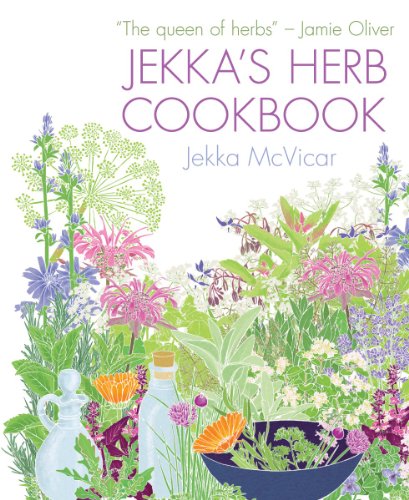Besides gardening, reading is one of my passions. My reading preference is non-fiction which includes cookbook reading. Reading cookbooks is my relaxation reading; I often do it while watching TV. Even though I rarely cook these days, I still enjoy reading recipes. I have a huge bookcase filled with cookbooks. I also have saved all my Bon Appetit and Gourmet magazines. In spite of all the cookbooks and recipes I own, and in spite of all the recipes that are online, I cannot resist going to the cookbook section in our local library and checking out all the new cookbooks.
Today I found what looks to be a interesting and fun cookbook to read because it not only has recipes using herbs, it also has herb information. It is called “Jekka’s Herb Cookbook” by Jekka McVicar, a Firefly book publication that came out this year, 2011.
When I saw Jekka in the title, I grabbed this cookbook without looking further on the library shelves. Jekka is hardly a common name, so if you have heard it once, it is a name you remember. I remember having the honor of meeting Jekka McVicar about 8 years ago when touring gardens in England and going to some of the Royal Horticultural Society gardens and shows. Jekka was near her seed display and surprisingly no one else seemed to be around: so my friends and I chatted with her and we all grabbed her seed catalogs and asked her to sign it. (Are you thinking that TheGardenLady is cheap? I like to think the word is frugal. After all, the garden tour wasn’t inexpensive.)
Jekka McVicar has one of the finest organic herb nurseries in England and on the cover of the book she is touted as “The queen of herbs.” See here. This large recipe book also has excellent, lovely illustrations done by her daughter.
Rock Samphire (Crithmum maritimum) by Phil Sellens
I have just started reading the book as I write this post and already I have discovered an herb that I have never heard of called Rock Samphire- Crithmum maritimum commonly called sea fennel. See here. Apparently its seed pods were used as a condiment and the leaves were enjoyed in salads in England and written about as early as 1597.
I must say that I was a bit disappointed with the chapter on Purslane- Portulaca oleracea which only shows the use of Purslane in salads. A friend had prepared it for me with spinach when I lived in the Middle East. So I always look for more cooked recipes using Purslane because a) it is a major weed in my garden so that I am in effect now raising it as an herb and b) it is low in calories and high in dietary fiber, minerals and vitamins. Fresh leaves contain surprisingly more Omega-3 fatty acids (α-linolenic acid) than any other leafy vegetable plant. So besides salad recipes, I am always hoping someone will show me exciting ways to cook purslane. I found this recipe from Central or South America and this recipe from Turkey both using purslane.
If TheGardenLady reader enjoys using herbs in cooking and wants to learn more about the herbs, check out ” Jekka’s Herb Cookbook “. Let readers know what you think of this book and/or recommend your favorite herb cookbook.
An interesting website about wild herbs in Maine with recipes is this.



